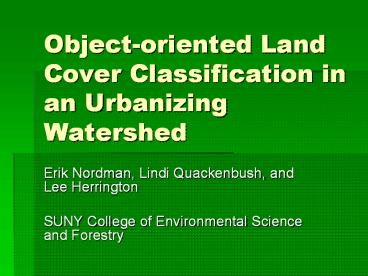Object-oriented Land Cover Classification in an Urbanizing Watershed - PowerPoint PPT Presentation
1 / 22
Title:
Object-oriented Land Cover Classification in an Urbanizing Watershed
Description:
Object-oriented Land Cover Classification in an Urbanizing Watershed ... SUNY College of Environmental Science and Forestry. Objectives ... – PowerPoint PPT presentation
Number of Views:125
Avg rating:3.0/5.0
Title: Object-oriented Land Cover Classification in an Urbanizing Watershed
1
Object-oriented Land Cover Classification in an
Urbanizing Watershed
- Erik Nordman, Lindi Quackenbush, and Lee
Herrington - SUNY College of Environmental Science and Forestry
2
Objectives
- Create a land cover classification
- Suitable for ArcHydro pollution model
- Up-to-date
- High spatial resolution
- Emphasis on impervious surface
Introduction Objectives Study
Area Methods Results Discussion Conclusions
3
Study Area
Introduction Objective Study
Area Methods Results Discussion Conclusions
4
Methods Imagery
- Satellite QuickBird (DigitalGlobe)
- 2.44 m multispectral resolution
- 4 bands (3 visible NIR)
- Created NDVI layer
- Collected over 2 dates
- Half on each date
- May and June 2005
Introduction Methods Imagery Software
Classification Results Discussion Conclusions
5
Detail of Imagery
Upper Lake
Introduction Methods Imagery Software
Classification Results Discussion Conclusions
Carmans River
6
eCognition Object-oriented classification
- Uses spectral, textural and thematic information
- Segmentation into homogeneous polygons (objects)
- Can vary the size (homogeneity) of polygons at
different levels
Introduction Methods Imagery Software
Classification Results Discussion Conclusions
7
Impervious Cover
- Critical to analyzing runoff and pollution
- Challenges
- High spatial resolution
- Individual roads, houses
- Tree canopy covers roads
Introduction Methods Imagery Software
Classification Results Discussion Conclusions
8
Impervious Cover
- Solution
- Use road vector layer
- ALIS data set
- For public safety
- NYS GIS Clearinghouse
- 10 meter buffer
Introduction Methods Imagery Software
Classification Results Discussion Conclusions
9
Level 2 Segmentation
Introduction Methods Imagery Software
Classification Results Discussion Conclusions
10
Level 1 Segmentation
Introduction Methods Imagery Software
Classification Results Discussion Conclusions
11
Detail ALIS roads in Level 2 segmentation
Introduction Methods Imagery Software
Classification Results Discussion Conclusions
12
Classification
- Classes based on TR-55
- Impervious
- Includes roads, driveways, roofs
- Tree, Grass
- Wetlands
- 3 classes woody, emergent, tidal
- Also from thematic layers
- Bare, Water
Introduction Methods Imagery Software
Classification Results Discussion Conclusions
13
Classification
- Attributes used in classification included
- Color and Brightness
- Area
- Shape Index and Compactness
- GLMC heterogeneity
- Proximity to objects in other classes
Introduction Methods Imagery Software
Classification Results Discussion Conclusions
14
Introduction Methods Results Discussion Conclusion
s
15
Introduction Methods Results Discussion Conclusion
s
16
Accuracy Assessment
- Reference data
- Digital orthophotos
- Acquired April, 2004
- Leaf-off
- Stratified random sample, 727 points
Introduction Methods Results Discussion Conclusion
s
17
Accuracy Assessment
- Overall 73.9
- Users accuracy of key classes
- Impervious 73.4
- Tree 74.5
- Grass 66.7
Introduction Methods Results Discussion Conclusion
s
18
Discussion
- Accuracy comparable to other studies
- ALIS road layer successfully used to aid
classification
Introduction Methods Results Discussion Conclusion
s
19
Discussion
- Seasonality
- Imagery leaf-on
- Orthophotos leaf-off
- Affected agreement between classification and
reference data - Scrub vegetation
- Confusion among bare, grass and tree classes
Introduction Methods Results Discussion Conclusion
s
20
Discussion
- Accuracy Assessment
- Response unit 1 pixel in classified image
- Response unit should be object, not pixel
Introduction Methods Results Discussion Conclusion
s
21
Conclusions
- QuickBird and eCognition produced a highly
detailed classification - Adequate for pollution and economic models
- Thematic layers proved useful
Introduction Methods Results Discussion Conclusion
s
22
Acknowledgements
- IAGT
- Provided satellite imagery
- NYS Department of State Division of Coastal
Resources - Provided financial support































